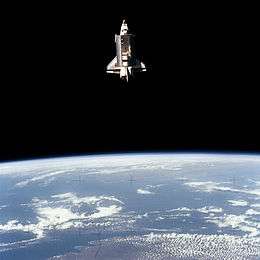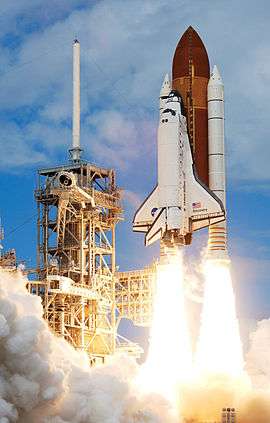Space Shuttle Enterprise
Coordinates: 40°45′53″N 74°00′03″W / 40.764832°N 74.000763°W
| Enterprise OV-101 | |
|---|---|
 Enterprise at SLC-6 at Vandenberg AFB | |
| OV designation | OV-101 |
| Country | United States |
| Contract award | July 26, 1972 |
| Named after | USS Enterprise (NCC-1701) (Star Trek starship) |
| Status | Retired, on display at Intrepid Museum, New York City |
| First flight |
ALT test flight on SCA February 18, 1977 |
| Last flight |
Ferry flight on SCA April 27, 2012 |
| Time spent in space |
Never flew in space |
|
Space Shuttle Enterprise | |
| Location | New York City |
| Built | 1976 |
| Built by | Rockwell International |
| NRHP Reference # | 13000071 |
| Added to NRHP | March 13, 2013 |
The Space Shuttle Enterprise (Orbiter Vehicle Designation: OV-101) was the first orbiter of the Space Shuttle system. Rolled out on September 17, 1976, it was built for NASA as part of the Space Shuttle program to perform atmospheric test flights after being launched from a modified Boeing 747.[1] It was constructed without engines or a functional heat shield, and was therefore not capable of spaceflight.[2]
Originally, Enterprise had been intended to be refitted for orbital flight to become the second space-rated orbiter in service.[1] However, during the construction of Space Shuttle Columbia, details of the final design changed, making it simpler and less costly to build Challenger around a body frame that had been built as a test article.[1] Similarly, Enterprise was considered for refit to replace Challenger after the latter was destroyed, but Endeavour was built from structural spares instead.[1][3]
Enterprise was restored and placed on display in 2003 at the Smithsonian's new Steven F. Udvar-Hazy Center in Virginia.[4] Following the retirement of the Space Shuttle fleet, Discovery replaced Enterprise at the Udvar-Hazy Center, and Enterprise was transferred to the Intrepid Sea, Air & Space Museum in New York City, where it has been on display since July 2012.[5]
Differences between Enterprise and future shuttles
The design of Enterprise was not the same as that planned for Columbia, the first flight model; the aft fuselage was constructed differently, and it did not have the interfaces to mount OMS pods. A large number of subsystems—ranging from main engines to radar equipment—were not installed on Enterprise, but the capacity to add them in the future was retained, as NASA originally intended to refit the orbiter for spaceflight at the conclusion of its testing. Instead of a thermal protection system, its surface was primarily covered with simulated tiles made from polyurethane foam. Fiberglass was used for the leading edge panels in place of the reinforced carbon–carbon ones of spaceflight-worthy orbiters. Only a few sample thermal tiles and some Nomex blankets were real.[6] Enterprise used fuel cells to generate its electrical power, but these were not sufficient to power the orbiter for spaceflight.[7]
Enterprise also lacked RCS thrusters (which were useless in atmospheric flight) and hydraulic mechanisms for the landing gear; the landing gear doors were simply opened through the use of explosive bolts and the gear dropped down solely by gravity.[7] As it was only used for atmospheric testing, Enterprise featured a large nose probe mounted on its nose cap, common on test aircraft because the location provides the most accurate readings for the test instruments, being mounted out in front of the disturbed airflow.
Enterprise was equipped with Lockheed-manufactured zero-zero ejection seats like those its sister Columbia had carried on its first four missions.[7]
Construction milestones
| Date | Milestone[8] |
|---|---|
| 1972 July 26 | Contract Award to North American Rockwell |
| 1972 August 9 | Construction authorization from NASA |
| 1974 June 4 | Start structural assembly of crew module at Downey plant |
| 1974 August 26 | Start structural assembly of aft fuselage at Downey plant |
| 1975 March 27 | Mid fuselage arrives at Palmdale from General Dynamics |
| 1975 May 23 | Wings arrive at Palmdale from Grumman |
| 1975 May 25 | Vertical stabilizer arrives at Palmdale from Fairchild Republic |
| 1975 August 25 | Start of Final Assembly |
| 1975 September 9 | Aft fuselage on dock, Palmdale |
| 1975 October 31 | Lower forward fuselage on dock, Palmdale |
| 1975 December 1 | Upper forward fuselage on dock, Palmdale |
| 1976 January 16 | Crew module on dock, Palmdale |
| 1976 March 3 | Payload bay doors on dock, Palmdale |
| 1976 March 12 | Complete final assembly and closeout systems installation |
| 1976 March 15 | Start functional checkout |
| 1976 June | Complete functional checkout, start ground vibration and proof load tests |
| 1976 September 17 | Rollout from Palmdale |
| 1976 October–November | Start systems retest, complete integrated systems checkout |
| 1977 February 18 | First captive flight |
| 1977 June 18 | First crewed captive flight[9] |
| 1977 August 12 | First free flight |
Service

Construction began on Enterprise on June 4, 1974.[1] Designated OV-101, it was originally planned to be named Constitution and unveiled on Constitution Day, September 17, 1976. A letter-writing campaign by Star Trek fans to President Gerald Ford asked that the orbiter be named after the Starship Enterprise. White House advisors cited "hundreds of thousands of letters" from Trekkies—"one of the most dedicated constituencies in the country"—as a reason for giving the shuttle the name. Although Ford did not publicly mention the campaign, the president—saying he was "partial to the name" Enterprise—directed NASA officials to change the name.[3][10][11]
In mid-1976 the orbiter was used for ground vibration tests, allowing engineers to compare data from an actual flight vehicle with theoretical models.[1]
On September 17, 1976, Enterprise was rolled out of Rockwell's plant at Palmdale, California. In recognition of its fictional namesake, Star Trek creator Gene Roddenberry and most of the principal cast of the original series of Star Trek were on hand at the dedication ceremony.[12]
Approach and landing tests (ALT)
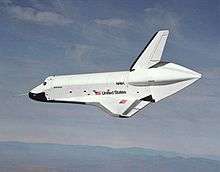

On January 31, 1977, Enterprise was taken by road to Dryden Flight Research Center at Edwards Air Force Base to begin operational testing.[1][13]
While at NASA Dryden Enterprise was used by NASA for a variety of ground and flight tests intended to validate aspects of the shuttle program.[14] The initial nine-month testing period was referred to by the acronym ALT, for "Approach and Landing Test".[1][15] These tests included a maiden "flight" on February 18, 1977, atop a Boeing 747 Shuttle Carrier Aircraft (SCA) to measure structural loads and ground handling and braking characteristics of the mated system. Ground tests of all orbiter subsystems were carried out to verify functionality prior to atmospheric flight.[9]
The mated Enterprise/SCA combination was then subjected to five test flights with Enterprise unmanned and unactivated. The purpose of these test flights was to measure the flight characteristics of the mated combination. These tests were followed with three test flights with Enterprise manned to test the shuttle flight control systems.[1]
On August 12, 1977, the space shuttle Enterprise flew on its own for the first time.[16] Enterprise underwent four more free flights where the craft separated from the SCA and was landed under astronaut control. These tests verified the flight characteristics of the orbiter design and were carried out under several aerodynamic and weight configurations.[15] The first three flights were flown with a tailcone placed at the end of Enterprise's aft fuselage, which reduced drag and turbulence when mated to the SCA. The final two flights saw the tailcone removed and mockup main engines installed. On the fifth and final glider flight, pilot-induced oscillation problems were revealed, which had to be addressed before the first orbital launch occurred.[14]

Mated Vertical Ground Vibration Test (MGVT)
Following the conclusion of the ALT test flight program, on March 13, 1978, Enterprise was flown once again, but this time halfway across the country to NASA's Marshall Space Flight Center (MSFC) in Alabama for the Mated Vertical Ground Vibration Testing (MGVT). The orbiter was lifted up on a sling very similar to the one used at Kennedy Space Center and placed inside the Dynamic Test Stand building, and there mated to the Vertical Mate Ground Vibration Test tank (VMGVT-ET), which in turn was attached to a set of inert Solid Rocket Boosters (SRB) to form a complete shuttle launch stack, and marked the first time in the program's history that all Space Shuttle elements, an Orbiter, an External Tank (ET), and two SRBs, were mated together. During the course of the program, Enterprise and the rest of the launch stack would be exposed to a punishing series of vibration tests simulating as closely as possible those expected during various phases of launch, some tests with and others without the SRBs in place.[17]
Planned preparations for spaceflight
At the conclusion of this testing, Enterprise was supposed to be taken back to Palmdale for retrofitting as a fully spaceflight capable vehicle. Under this arrangement, Enterprise would be launched on its maiden spaceflight in July 1981 to launch a communications satellite and retrieve the Long Duration Exposure Facility, then planned for a 1980 release on the first operational orbiter, Columbia. Afterwards, Enterprise would conduct two Spacelab missions.[18] However, in the period between the rollout of Enterprise and the rollout of Columbia, a number of significant design changes had taken place, particularly with regard to the weight of the fuselage and wings, which meant retrofitting the prototype would have been a much more expensive process than previously realized, requiring the dismantling of the orbiter and the return of various sections to subcontractors across the country. As a consequence, NASA took the decision to convert an incomplete Structural Test Article, numbered STA-099, which had been built to undergo a variety of stress tests, into a fully flight-worthy orbiter, which became Challenger.
- Planned orbital missions[18]
| # | Date | Designation | Launch pad | Notes |
|---|---|---|---|---|
| 1 | July 16, 1981 | STS-17 | 39-A | deployment of Intelsat V satellite and retrieval of Long Duration Exposure Facility |
| 2 | September 30, 1981 | STS-20 | 39-A | Spacelab mission |
| 3 | November 25, 1981 | STS-22 | 39-A | Spacelab mission |
Preparation for STS-1
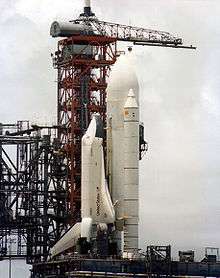
Following the MGVT program and with the decision to not use Enterprise for orbital missions, it was ferried on April 10, 1979, to KSC. By June 1979, it was again mated with an external tank and solid rocket boosters (known as a boilerplate configuration) and tested in a launch configuration at Kennedy Space Center Launch Pad 39A for a series of fit checks of the facilities there.[3]
Retirement
With the completion of critical testing, Enterprise was returned to Rockwell's plant in Palmdale in October 1979 and was partially disassembled to allow certain components to be reused in other shuttles. After this period, Enterprise was returned to NASA's Dryden Flight Research Facility in September 1981.[20] During 1983 and 1984, Enterprise underwent an international tour visiting France, Germany, Italy, the UK, Canada, and the American states of California, Alabama, and Louisiana (during the 1984 Louisiana World Exposition). It was also used to fit-check the never-used shuttle launch pad at Vandenberg AFB, California. Finally, on November 18, 1985, Enterprise was ferried to Washington, D.C., where it became property of the Smithsonian Institution.[3]
Post-Challenger
After the Challenger disaster, NASA considered using Enterprise as a replacement. Refitting the shuttle with all of the necessary equipment for it to be used in space was considered, but NASA decided to use spares constructed at the same time as Discovery and Atlantis to build Endeavour.[3]
Post-Columbia

In 2003 after the breakup of Columbia during re-entry, the Columbia Accident Investigation Board conducted tests at Southwest Research Institute, which used an air gun to shoot foam blocks of similar size, mass and speed to that which struck Columbia at a test structure which mechanically replicated the orbiter wing leading edge. They removed a fiberglass panel from Enterprise's wing to perform analysis of the material and attached it to the test structure, then shot a foam block at it.[21] While the panel was not broken as a result of the test, the impact was enough to permanently deform a seal. Since the reinforced carbon-carbon (RCC) panel on Columbia had only 40% of the strength of the test panel from Enterprise, this result suggested that the RCC leading edge would have been shattered. Additional tests on the fiberglass were canceled in order not to risk damaging the test apparatus, and a panel from Discovery was tested to determine the effects of the foam on a similarly-aged RCC leading edge. On July 7, 2003, a foam impact test created a hole 41 by 42.5 cm (16.1 by 16.7 in) in the protective RCC panel. The tests clearly demonstrated that a foam impact of the type Columbia sustained could seriously breach the protective RCC panels on the wing leading edge.
The board determined that the probable cause of the accident was that the foam impact caused a breach of a reinforced carbon-carbon panel along the leading edge of Columbia's left wing, allowing hot gases generated during re-entry to enter the wing and cause structural collapse. This caused Columbia to tumble out of control, breaking up with the loss of the entire crew.
Museum exhibit

Washington, D.C.
From 1985 to 2003,[9] Enterprise was stored at the Smithsonian's hangar at Washington Dulles International Airport before it was restored and moved to the Smithsonian's newly built National Air and Space Museum Steven F. Udvar-Hazy Center at Washington Dulles, where it was the centerpiece of the space collection.[22] On April 12, 2011, NASA announced that Discovery, the most traveled orbiter in the fleet, would be added to the collection once the Shuttle fleet was retired. On April 17, 2012, Discovery was transported by Shuttle Carrier Aircraft to Dulles from Kennedy Space Center, where it made several passes over the Washington D.C. metro area.[23][24]
New York
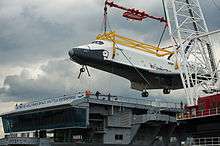

On December 12, 2011, ownership of the Enterprise was officially transferred to the Intrepid Sea, Air & Space Museum in New York City.[25][26][27] In preparation for the anticipated relocation, engineers evaluated the vehicle in early 2010 and determined that it was safe to fly on the Shuttle Carrier Aircraft once again.[28] At approximately 13:40 UTC on April 27, 2012, Enterprise took off from Dulles International Airport en route to a fly-by over the Hudson River, New York's JFK International Airport, the Statue of Liberty, the George Washington and Verrazano–Narrows Bridges, and several other landmarks in the city, in an approximately 45-minute "final tour". At 15:23 UTC, Enterprise touched down at JFK International Airport.[29][30]
The mobile Mate-Demate Device and cranes were transported from Dulles to the ramp at JFK and the shuttle was removed from the SCA overnight on May 12, 2012, placed on a specially designed flat bed trailer and returned to Hangar 12.[31] On June 3 a Weeks Marine barge took Enterprise to Jersey City. The Shuttle sustained cosmetic damage to a wingtip when a gust of wind blew the barge towards a piling.[32] It was hoisted June 6 onto the Intrepid Museum in Manhattan.[33]
The Enterprise went on public display on July 19, 2012, at the Intrepid Museum's new Space Shuttle Pavilion, a temporary shelter consisting of a pressurized, air-supported fabric bubble constructed on the aft end of the carrier's flight deck.[34]
On October 29, 2012, storm surges from Hurricane Sandy caused Pier 86, including the Intrepid Museum's visitor center, to flood, and knocked out the museum's electrical power and both backup generators. The loss of power caused the Space Shuttle Pavilion to deflate, and high winds from the hurricane caused the fabric of the Pavilion to tear and collapse around the orbiter. Minor damage was spotted on the vertical stabilizer of the orbiter, as a portion of the tail fin above the rudder/speedbrake had broken off.[35] The broken section was recovered by museum staff. While the pavilion itself could not be replaced for some time in 2013, the museum erected scaffolding and sheeting around Enterprise to protect it from the environment.[36]
By April 2013, the damage sustained to Enterprise's vertical stabilizer had been fully repaired, and construction work on the structure for a new pavilion was under way.[37] The pavilion and exhibit reopened on July 10, 2013.[38]
The Enterprise was listed on the National Register of Historic Places on March 13, 2013, reference number 13000071, in recognition of its role in the development of the Space Shuttle Program. The historic significance criteria are in space exploration, transportation, and engineering.[39]
Gallery
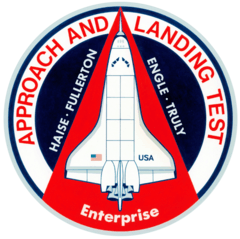 Enterprise ALT Program Logo
Enterprise ALT Program Logo Space Shuttle Enterprise 747 separation
Space Shuttle Enterprise 747 separation Enterprise makes its first appearance on the pad mated with an external tank and SRBs
Enterprise makes its first appearance on the pad mated with an external tank and SRBs.jpg) Enterprise over New York. The Intrepid Sea, Air & Space Museum, Enterprise's final home, can be seen below
Enterprise over New York. The Intrepid Sea, Air & Space Museum, Enterprise's final home, can be seen below
See also
- Buran (spacecraft)
- List of human spaceflights
- List of Space Shuttle crews
- List of Space Shuttle missions
- National Register of Historic Places listings in Manhattan from 14th to 59th Streets
- Timeline of Space Shuttle missions
References
- 1 2 3 4 5 6 7 8 9 Jenkins, Dennis R (2007). Space Shuttle: The History of the National Space Transportation System. Voyageur Press. ISBN 0-9633974-5-1.
- ↑ Slovinac, Patricia; Deming, Joan (June 2010). Avionics Systems Laboratory/Building 16: Historical Documentation. NASA. JSC-CN-22284.
- 1 2 3 4 5 Grinter, Kay (October 3, 2000). "Enterprise (OV-101)". NASA.gov. Archived from the original on March 26, 2015. Retrieved November 28, 2007.
- ↑ "National Air and Space Museum Steven F. Udvar-Hazy Center". NASA. October 23, 2003. Retrieved September 30, 2015.
- ↑ D'Orazio, Dante (July 18, 2012). "NASA Space Shuttle Enterprise aboard the USS Intrepid in pictures". The Verge. Retrieved September 30, 2015.
- ↑ "Space Shuttle, "Enterprise" OV-101". SI.edu. Smithsonian Institution. Retrieved January 9, 2013.
- 1 2 3 Lethbridge, Cliff (1998). "Space Shuttle Enterprise (OV-101) Fact Sheet". Spaceline.org. Archived from the original on January 7, 2011.
- ↑ Garrett, David; Gordon, Bob (August 25, 1976). "Shuttle roll-out set for 17 September 1976" (Press release). NASA News. 76N-32224. Retrieved June 16, 2013.
- 1 2 3 Gebhardt, Chris (April 27, 2012). "Space Shuttle Enterprise – The Orbiter that started it all". NASA Spaceflight. Retrieved June 18, 2015.
- ↑ Lewine, Frances (September 6, 1976). "Star Trek Fans Win on Space Shuttle". The Lewiston Daily Sun. p. 20. Retrieved March 5, 2011.
- ↑ Strauss, Mark (July 10, 2014). "Declassified Memos Reveal Debate Over Naming the Shuttle "Enterprise"". io9. Retrieved August 21, 2015.
- ↑ Rioux, Terry Lee (2005). From Sawdust to Stardust: The Biography of DeForest Kelley, Star Trek's Dr. McCoy. Pocket Books. p. 221. ISBN 0743457625.
- ↑ Dismukes, Kim (February 15, 2005). "Space Shuttle Basics". NASA.gov. Retrieved November 28, 2007.
- 1 2 "Space Shuttle Approach and Landing Tests (ALT)". NASA.gov. Retrieved November 28, 2007.
- 1 2 "Shuttle Enterprise Free Flight". NASA.gov. 2000. Retrieved November 28, 2007.
- ↑ Futz, Bob (1977). "1977 Year in Review: Space Shuttle Enterprise". UPI.com. United Press International. Retrieved January 9, 2013.
- ↑ Baker, David (2011). NASA Space Shuttle: 1981 onwards (all models): An Insight into the Design, Construction and Operation of the NASA Space Shuttle. Owners' Workshop Manual. Zenith Press. ISBN 978-0-7603-4076-9.
- 1 2 Portree, David S F (March 24, 2012). "What Shuttle Should Have Been: The October 1977 Flight Manifest". Wired.com. Archived from the original on March 26, 2012. Retrieved November 7, 2012.
- ↑ "Shuttle Orbiter Enterprise on Launch Complex 39". NASA.gov. June 1, 1979. Retrieved January 21, 2008.
- ↑ "Enterprise (OV-101)". NASA.gov. October 3, 2000. Retrieved November 7, 2012.
- ↑ Harwood, William (June 4, 2003). "Critical foam impact test planned for Thursday". SpaceflightNow.com. Retrieved July 12, 2007.
- ↑ Wilson, Jim (October 29, 2004). "Shuttle Enterprise at Center of Museum's Space Hangar". NASA.gov. Retrieved November 28, 2007.
- ↑ Heiney, Anna (April 17, 2012). "Discovery Departs Kennedy Space Center". NASA.gov. Retrieved April 17, 2012.
- ↑ Vastag, Brian (April 18, 2012). "Space shuttle Discovery makes final flight over Washington D.C.". Washington Post. Retrieved April 19, 2012.
- ↑ Pearlman, Robert Z (December 12, 2011). "Intrepid Museum Celebrates Ownership of Space Shuttle Enterprise". CollectSpace.com. Retrieved January 30, 2012.
- ↑ Rainey, Kris (December 11, 2011). "NASA Transfers Enterprise Title to Intrepid Sea, Air & Space Museum in New York City". NASA.gov. Retrieved January 30, 2012.
- ↑ Raskin, Deborah; Sacks, Luke (November 22, 2011). "NASA Transfers Title to Space Shuttle Orbiter Enterprise to the Intrepid Sea, Air & Space Museum in New York City" (Press release). PRWeb.com. Retrieved March 27, 2012.
- ↑ Bergin, Chris (March 14, 2010). "Enterprise in good condition for potential SCA ferry from Smithsonian NASM". NASAspaceflight.com. Retrieved March 16, 2010.
- ↑ "Space shuttle Enterprise lands safely in New York, after soaring over northern N.J.". NJ.com. Associated Press. April 27, 2012. Retrieved June 4, 2016.
- ↑ Shallwani, Pervaiz; Fox, Alison (April 27, 2016). "A Shuttle Meets Its City". The Wall Street Journal. Retrieved June 4, 2016.
- ↑ Pearlman, Robert Z (March 1, 2012). "Space shuttle Enterprise lands in New York City on April 23". CollectSpace.com. Retrieved March 22, 2012.
- ↑ Ludka, Alexandra (June 5, 2012). "Space Shuttle Enterprise Damaged On Way to New Home". ABC News. Retrieved June 7, 2012.
- ↑ "Enterprise to spend day in Jersey City". NJ.com. Associated Press. June 4, 2012. Retrieved June 7, 2012.
- ↑ Katz, Alex (July 18, 2012). "Space shuttle Enterprise set to open to public". The Bradenton Herald. Retrieved July 18, 2012.
- ↑ Pearlman, Robert Z (October 30, 2012). "Space Shuttle Enterprise Damaged by Hurricane Sandy". Space.com. Retrieved October 31, 2012.
- ↑ Pearlman, Robert Z (December 20, 2012). "Shuttle Enterprise Being Repaired as Museum Home Reopens Friday". Space.com. Retrieved January 9, 2012.
- ↑ Pearlman, Robert Z (April 30, 2013). "Space Shuttle Enterprise's New Home Takes Shape at NYC Museum". Space.com. Retrieved June 17, 2013.
- ↑ Gerberg, Jon (July 10, 2013). "Space shuttle Enterprise reopens to NYC visitors". The Big Story. Associated Press. Archived from the original on August 20, 2013.
- ↑ Bagrow, Daniel A. (March 13, 2013). "Space Shuttle Enterprise". NPS.gov. National Register of Historic Places. Retrieved March 22, 2013.
- Attribution
![]() This article incorporates public domain material from websites or documents of the National Aeronautics and Space Administration.
This article incorporates public domain material from websites or documents of the National Aeronautics and Space Administration.
External links
| Wikimedia Commons has media related to Space Shuttle Enterprise. |
- Enterprise (OV-101) at NASA.gov
| Spacecraft named Enterprise |
|---|
| NASA Space Shuttle (1976–1985) • Virgin Space Ship (2009–2014) • Star Trek starships (Fictional) |

